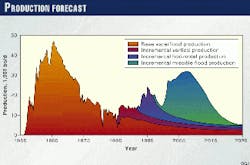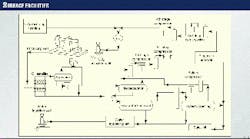Project brings commercial-scale CO2 miscible flooding to Canada
The Weyburn CO2 project will be the first carbon dioxide miscible flood on a commercial scale in Canada.
After its CO2 supply pipeline is built and the flood demonstrates the potential of this tertiary recovery method, many other new floods will likely emerge in Canada.
The PanCanadian Resource-operated Weyburn project is under construction and will be ready for CO2 injection in fall 2000. About 6 months later, PanCanadian expects production will begin to increase. By 2008, production will reach the 30,000 bo/d level compared with the 10,000 bo/d expected if the flood had not been installed.
This project is the most significant development in the southeastern Saskatchewan oil patch since the discovery of the Weyburn field in 1955.
Weyburn Unit
The Weyburn Unit contains one of the largest medium-sour crude oil reservoirs in Canada, with original oil in place of about 1.4 billion bbl (Fig. 1). The field has been waterflooded since 1964 and includes 652 producing and 168 water-injection wells. These numbers include over 140 horizontal wells, added over the past 7 years.
The unit has been a successful operation for PanCanadian Resources, as operator, and for the many working interest owners in the unit. It is in a fast production decline, however, and becoming a challenge to operate at profitable levels. Without some kind of tertiary recovery, the unit would soon have to be suspended or a large number of producing wells would have to be abandoned.
The unit covers over 70 sq miles in southeastern Saskatchewan. The Weyburn oil pool produces 25-34° API medium-gravity sour crude from the Midale beds of the Mississippian Charles formation. The Midale beds have two layers: the marly and vuggy zones.
The marly is a chalky dolomite with low permeability. The vuggy zone, below the marly, is a highly fractured and permeable limestone. Waterflooding has recovered oil mostly from the vuggy zone and much less from the marly zone.
The construction of a commercial scale CO2 flood will mark a step change in the complexity of the Weyburn production operation. The oil recovery factor from the project will likely increase from 30%, achieved with conventional waterflood, to 46% with a CO2 flood.
This means that at least an additional 120 million bbl of oil will be produced over the next 20 years. In the 40 years since the field was discovered, 330 million bbl of oil have been produced.
Project scope
On June 26, 1997, PanCanadian Petroleum Ltd. and its partners in the unit announced the signing of a CO2 supply agreement with Dakota Gasification Co. (DGC). A wholly owned subsidiary of Basin Electric & Power Co-Operative of Bismarck, ND, DGC owns and operates the Great Plains synfuels plant, near Beulah, ND. The plant produces 160 MMcfd of natural gas from coal gasification.
A by-product of the gasification process, CO2 will be transported in a dense phase from Beulah to Weyburn via a 330-km pipeline, currently under construction (Fig. 2). DGC is building the pipeline and will operate it.
DGC currently vents the CO2 to the atmosphere but 95 MMcfd of the 240 MMcfd available supply will be injected into the Weyburn reservoir in fall 2000. The CO2 from DGC will be sufficient for the entire target area within the Weyburn Unit.
The target area, consisting of 75 inverted nine-spot patterns, has been selected with geological and reservoir models of the Weyburn field. The initial field development, Phase 1a, includes conversion of 19 patterns to CO2 injection. On-trend producing wells will be converted to injection, but the pattern management philosophy will be maintained. The flood will be monitored on a pattern-by-pattern basis
As demonstrated in many mature CO2 floods in the Permian basin, water injection is not replaced by CO2, but water injection rates are adjusted to maximize the benefits of CO2 miscible flooding.
The 75 injection patterns entail the construction of more than 900 km of new pipelines and up to 19 new production satellites. The front-end engineering design and most of the detailed engineering are complete for the first 19 CO2 injection patterns, and construction is under way.
Development of the remaining 56 patterns will be based on installation work for the initial 19 patterns. Fig. 1b highlights the areal extent of the 75 patterns and the anticipated construction phases.
Apart from giving new life to an old field, the miscible flood has the potential to be recognized as the world's largest joint-implementation project for reducing CO2 emissions. Joint implementation involves the combined efforts of two nations to reduce gas emissions to the atmosphere, which some researchers claim will affect global climate.
This project is significant on many levels. It is the largest capital commitment in PanCanadian's history and will have a significant impact, because of its size and duration, on the economies of both North Dakota and Saskatchewan.
The number of direct and indirect jobs attributed to the miscible flood will peak at 1,400 jobs around 2010.
Operating strategies
The CO 2 flood design for Weyburn is more than just a carbon copy of similar CO 2 floods in the Permian basin. Research at the University of Regina and by the Saskatchewan Research Council has been used to customize the standard miscible-flood techniques.These new production strategies have been tested with reservoir and geological models developed by PanCanadian. Also, the results from these theoretical models have been tested with an overall risk model that accounts for the project's technical and economic uncertainties.1
Due to the complex geology of the field, four different operating strategies have been identified for use in the flood (Fig. 1c), as follows:
- Straight gas injection (SGI).
- Water-alternating-gas (WAG) process in the vuggy (VWAG).
- WAG process in the marly and vuggy (MVWAG).
- Simultaneous but separate water and gas injection (SSWG).
SGI will be in patterns with low historical production or injection rates. The current design calls for 19 SGI patterns with both horizontal and vertical producers. The injection wells will be vertical (Fig. 3a).
Vuggy patterns (VWAGs) will be in areas having thin marly pay. The current design incorporates 10 VWAG patterns (Fig. 3b). These patterns will not have horizontal wells.
MVWAG patterns will be in areas where both the marly and vuggy pay are thick. Plans call for 26 of these patterns. Fig. 3c shows a MVWAG pattern after switching it to the initial WAG cycle. Water is being injected in one pattern, while CO2 injection is occurring in the other pattern. The MVWAG operating strategy incorporates both vertical and horizontal producers. Injection will be done through vertical wells.
The fourth pattern, SSWG patterns, target the most productive area of the miscible flood. These patterns are designed to maximize recovery from a tight marly zone overlaying a good vuggy zone. Water will be injected continuously into the vertical injectors, while CO2 is being injected continuously into the horizontal injectors. Producers will be both vertical and horizontal wells.
Fig. 3d shows a reservoir cross-section in a SSWG pattern during the initial CO2 stage, in which CO2 is preferentially flooding the high-permeability vuggy zone. This design is experimental in nature but should obtain maximum recovery in this high-energy reservoir environment.
Using these production strategies, PanCanadian expects maximum production rates from the field of about 30,000 bo/d (Fig. 4).
Phase 1a, currently under construction, will have only SSWG and VWAG patterns. These patterns are expected to have a fast oil and CO2 production response for the following reasons:
- Continuous reservoir and a geological sequences promote gravity segregation.
- CO2 swelling of the Weyburn Midale crude significantly reduces the crude's viscosity factor.
- Reduced spacing because of horizontal wells will make the CO2 process very efficient.
- Minimum miscibility pressure can be easily achieved.
- A very successful waterflood indicates good injected-fluid control.
Flood facilities
The existing Weyburn facilities can handle oil and water production with a very small amount of solution gas, 30 cu m/cu m GOR. The CO2 project will require new equipment for converting this facility to one that can handle high-pressure gas. Fig. 5 illustrates the facility after the new equipment is installed.
The new facilities will include a new free-water knockout vessel, a new battery gas and recycle compressor package, and a new flare system.2 The existing treaters are expected to handle the new production rates, but the existing free-water knockout is too small to accommodate the increased gas production rates.
The new battery gas compressor will conserve the CO2-rich solution gas for reinjection.
A network of medium-pressure gas gathering lines will be built to transport the solution gas and CO2 mixture from the production satellites to a new recycle central compression station. This gas will be compressed and the recycled mixture will then be blended with purchased CO2 and reinjected through a new CO2 injection distribution network.
The impact of adding produced CO2 to the existing oil treating facility will be considerable. The CO2, sour-gas, compression equipment alone represents a significant addition to the existing oil battery.
The project also requires the drilling of new wells. Dual-legged horizontal wells will be completed to provide horizontal injection wells for the SSWG patterns. In addition, horizontal production wells will also be required in the CO2 flood target area.
Finally, the reactivation of suspended and abandoned producing wells in the CO2 flood project area will require both drilling and service rig activity.
Overall, 54 new wells will be drilled and more than 600 wells will be either upgraded, converted, or reactivated.
References
- Barnhart, W.D., and Coulthard, C., "Weyburn CO2 Miscible Flood Conceptual Design and Risk Assessment," 6th Petroleum Conference of South Saskatchewan Section of the Petroleum Society of CIM, October 1995.
- Wey, B., and Hancock, S.K, "Weyburn CO2 Miscible Flood Project Field Production and Pipeline Operation Impacts," 11th Saskatchewan Petroleum Conference, October 1999.
The Author
Susan K. Hancock is responsible for the overall management of engineering and geology in the Weyburn area for PanCanadian Resources, Calgary. Her work includes the CO2 miscible flood, Lougheed, joint ventures, and acquisitions and divestitures. Before joining PanCanadian, she worked for Norcen Energy Resources Ltd. in marketing and engineering.
Hancock holds a BS in chemical engineering from the University of Calgary and an MBA from the University of Calgary.


